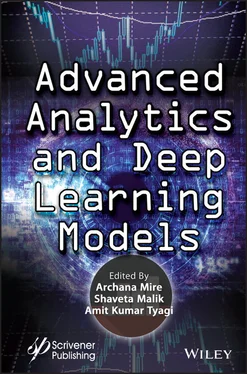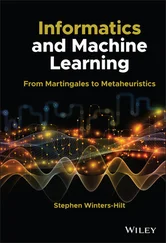Advanced Analytics and Deep Learning Models
Здесь есть возможность читать онлайн «Advanced Analytics and Deep Learning Models» — ознакомительный отрывок электронной книги совершенно бесплатно, а после прочтения отрывка купить полную версию. В некоторых случаях можно слушать аудио, скачать через торрент в формате fb2 и присутствует краткое содержание. Жанр: unrecognised, на английском языке. Описание произведения, (предисловие) а так же отзывы посетителей доступны на портале библиотеки ЛибКат.
- Название:Advanced Analytics and Deep Learning Models
- Автор:
- Жанр:
- Год:неизвестен
- ISBN:нет данных
- Рейтинг книги:5 / 5. Голосов: 1
-
Избранное:Добавить в избранное
- Отзывы:
-
Ваша оценка:
- 100
- 1
- 2
- 3
- 4
- 5
Advanced Analytics and Deep Learning Models: краткое содержание, описание и аннотация
Предлагаем к чтению аннотацию, описание, краткое содержание или предисловие (зависит от того, что написал сам автор книги «Advanced Analytics and Deep Learning Models»). Если вы не нашли необходимую информацию о книге — напишите в комментариях, мы постараемся отыскать её.
The book provides readers with an in-depth understanding of concepts and technologies related to the importance of analytics and deep learning in many useful real-world applications such as e-healthcare, transportation, agriculture, stock market, etc.
Audience
Advanced Analytics and Deep Learning Models — читать онлайн ознакомительный отрывок
Ниже представлен текст книги, разбитый по страницам. Система сохранения места последней прочитанной страницы, позволяет с удобством читать онлайн бесплатно книгу «Advanced Analytics and Deep Learning Models», без необходимости каждый раз заново искать на чём Вы остановились. Поставьте закладку, и сможете в любой момент перейти на страницу, на которой закончили чтение.
Интервал:
Закладка:
1.2 Evolution of CALL
In the 1960s, the audio-lingual method was introduced for English language teaching (ELT), which essentially insisted on drill and practice which became quite easier with the incorporation of computer in teaching and learning language [6, 7]. By the 20th century, CALL had a great impact on language teaching and learning. CALL during 1960s and 1980s can be termed as Structural CALL, as during this period, the computers used in language learning were mainly for drills and practice. Following the Structural approach and Behaviorist theory of learning, the computers programs focused more on structured and rote learning than interactivity. During this period, accuracy in grammar and sentence structure were the primary aims for language learning. The second phase of CALL between 1980s and 1990s is known as Communicative CALL. Computers used during this period were majorly for constructing exercises to develop efficacious communication. During this period, the integration of computers in language learning was not only for accuracy but also for achieving fluency. It encouraged interaction not only with the computers but also with the fellow learners. From the 1990s to the early 21st century, integrative CALL was marked by increased access to digital resources and the Internet [8]. The advancement in technology and easy access to the internet encouraged the educators to invent flexible classroom language learning lessons that could be easily accessed even outside the classroom. In the early 21st century, the Integrative CALL continued to have an impact on language learning. Davies et al. argue that the field was infused with the era’s “Web 2.0 fever” [9]. This included the emergence of a slew of new communities based on Web 2.0 tools like wikis, social networking sites, discussion boards, and virtual worlds. The best examples are Facebook groups, Instagram, and Twitter.
Technology has become an integral part of our lives. Its presence is ubiquitous right from the time we wake up till the time we sleep in various forms like alarms, smart phone, smart TV, smart AC, laptop, tablet, Whats App, You Tube, and many others. Technology has become so prevalent in every sector and at every level of education that it is impossible to imagine one’s existence without it in any form. The majority of language learners around the world today use technology to access materials in their second and foreign languages, communicate with people all over the world, learn at their own pace, and take several language tests such as the TOEFL and IELTS [10–12]. Technology helps us get connected with anyone at any part of the world and so the language learners can easily get connected to larger connected networks of native language speakers where they can learn a language by getting directly exposed to the target language. Hence, it would not be wrong to say that the significant development of ICT has changed the way we understand learning and consequently has led to a shift from traditional approaches to teaching to networked teaching and learning.
In this context of language learning and teaching, it is worth noting that Warschauer and Kern coined the concept of Network-Based Language Teaching (NBLT), which focuses on communication [13]. According to Sharples et al. , there is a fundamental correlation between learner-centered, personalized, interactive, collaborative, situated, lifelong, and ubiquitous New Learning and New Technology, which is well known for being mobile, user-friendly, and ubiquitous [14]. According to Jones, Networked Learning (NL) has emerged as a significant paradigm in which ICT is used to foster interaction and connections between teachers and learners, learners and other learners, and a learning community and its learning resources [15]. Further, with the Fourth Industrial Revolution which features rapid expansion of technology and digital application is influencing all spheres of our lives. AI has made an impact on the way we live and work, that is, from floor cleaning, using automatic induction heaters, driverless cars to instructing Alexa. According to Manns, the Fourth Industrial Revolution is being driven by the integration and amplification of emerging breakthroughs in AI, automation, and robotics, as well as the far-reaching connection between billions of people with mobile devices that provide unparalleled access to data and information [16]. Furthermore, AI now has major applications for language studies, thanks to advances in NLP, the advent of NL, and the technological ability to manage large amount of data.
1.3 Defining Artificial Intelligence
Artificial Intelligence (AI) is a branch of science that studies and develops devices aimed at stimulating human intelligence processes. The primary aim of AI is to improve the speed and efficacy of regular processes. As a result, the number of industries implementing AI is growing globally [17].
The term AI as defined by Russell and Norvig is Computational Intelligence, or Machine Intelligence, which encompasses a wide range of subfields in which “specific tasks, such as playing chess, proving mathematical theorems, writing poetry, and diagnosing diseases, can be performed” [18]. According to Housman, “AI is capable of two things: (1) automating repetitive tasks by predicting outcomes on data that has been labeled by human beings, and (2) enhancing human decision-making by feeding problems to algorithms developed by humans” [19]. To put it another way, AI registers assigned commands by performing the tasks repeatedly and then generates a decision pathway for humans by presenting alternatives. Moreover, Nabiyev describes AI as a computer-controlled device’s ability to execute tasks in a human-like manner [20]. According to the author, human-like features include mental processes like reasoning, meaning formation, generalization, and learning from prior experiences. Nilsson goes on to describe AI as the full algorithmic edifice that mimics human intellect [21]. According to him, AI encompasses the development of the information-processing theory of intelligence.
1.4 Historical Overview of AI in Education and Language Learning
AI has evolved in terms of its philosophical approach over time. Intelligent Tutoring Systems (ITSs) were the first to incorporate AI into language learning in the 1980s aimed for personalized and autonomous learning. Early iterations of ITS were referred to as programs that sought to cater to the needs of learners by facilitating communication [22]. Another significant benefit of ITS was that it allowed for infinite repetitions and practice, something that could never be done with a human instructor. It was designed for the individual learner who wanted to improve their language skills by using tutoring systems. Despite of its advantages, several studies on integration of ITS in higher education found that it had moderate positive impact on the academic learning of college students [23]. However, after four decades, the more advanced and updated version of AI has revitalized the potential for personalized learning [24].
Although ITS made extensive use of drill and rote-learning mechanism built into the computer-based learning system, today’s AI applications are much more advanced, with the same aim of catering to personalized learning. The fundamental difference between the previous model of ITS and the current model is that the former involved a student working in isolation using an ITS and the later engages students in a networked environment. This exposes the learner to the authentic and natural learning scenarios providing social context for language learning.
As mentioned earlier, the remarkable advancement in AI has brought a significant and inevitable shift from CALL to ICALL. With advancements in mobile technologies and their applications in language learning, CALL paved the way for MALL, and similarly, development in AI has led to the rise of a new academic field called ICALL. NLP technologies’ language processing capabilities have numerous implications in the field of CALL, and the field of study that investigates and integrates such implementations is known as ICALL [25].
Читать дальшеИнтервал:
Закладка:
Похожие книги на «Advanced Analytics and Deep Learning Models»
Представляем Вашему вниманию похожие книги на «Advanced Analytics and Deep Learning Models» списком для выбора. Мы отобрали схожую по названию и смыслу литературу в надежде предоставить читателям больше вариантов отыскать новые, интересные, ещё непрочитанные произведения.
Обсуждение, отзывы о книге «Advanced Analytics and Deep Learning Models» и просто собственные мнения читателей. Оставьте ваши комментарии, напишите, что Вы думаете о произведении, его смысле или главных героях. Укажите что конкретно понравилось, а что нет, и почему Вы так считаете.












